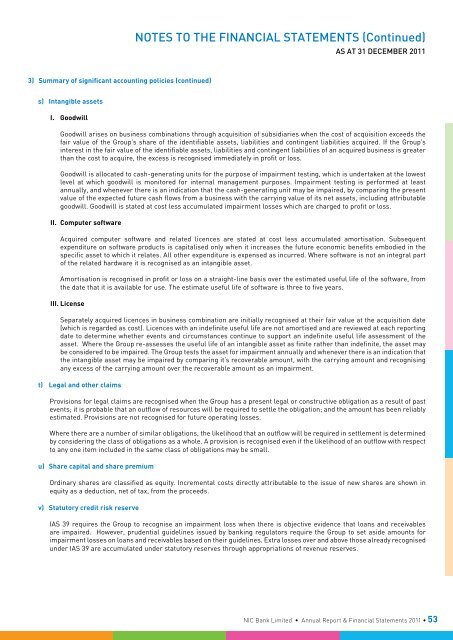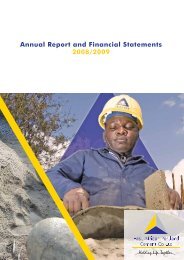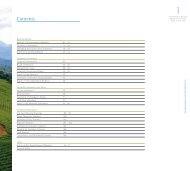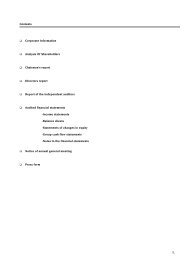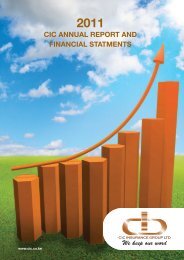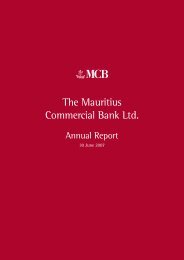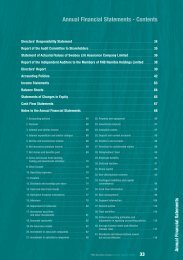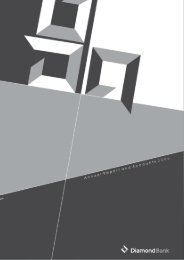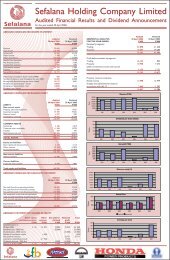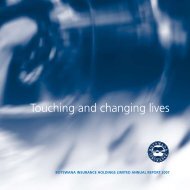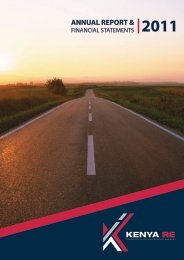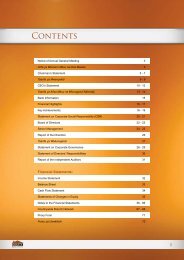Financial Statements 2011 - Investing In Africa
Financial Statements 2011 - Investing In Africa
Financial Statements 2011 - Investing In Africa
You also want an ePaper? Increase the reach of your titles
YUMPU automatically turns print PDFs into web optimized ePapers that Google loves.
Notes To The <strong>Financial</strong> <strong>Statements</strong> (Continued)<br />
As at 31 december <strong>2011</strong><br />
3) Summary of significant accounting policies (continued)<br />
s) <strong>In</strong>tangible assets<br />
I. Goodwill<br />
Goodwill arises on business combinations through acquisition of subsidiaries when the cost of acquisition exceeds the<br />
fair value of the Group’s share of the identifiable assets, liabilities and contingent liabilities acquired. If the Group’s<br />
interest in the fair value of the identifiable assets, liabilities and contingent liabilities of an acquired business is greater<br />
than the cost to acquire, the excess is recognised immediately in profit or loss.<br />
Goodwill is allocated to cash-generating units for the purpose of impairment testing, which is undertaken at the lowest<br />
level at which goodwill is monitored for internal management purposes. Impairment testing is performed at least<br />
annually, and whenever there is an indication that the cash-generating unit may be impaired, by comparing the present<br />
value of the expected future cash flows from a business with the carrying value of its net assets, including attributable<br />
goodwill. Goodwill is stated at cost less accumulated impairment losses which are charged to profit or loss.<br />
II. Computer software<br />
Acquired computer software and related licences are stated at cost less accumulated amortisation. Subsequent<br />
expenditure on software products is capitalised only when it increases the future economic benefits embodied in the<br />
specific asset to which it relates. All other expenditure is expensed as incurred. Where software is not an integral part<br />
of the related hardware it is recognised as an intangible asset.<br />
Amortisation is recognised in profit or loss on a straight-line basis over the estimated useful life of the software, from<br />
the date that it is available for use. The estimate useful life of software is three to five years.<br />
III. License<br />
Separately acquired licences in business combination are initially recognised at their fair value at the acquisition date<br />
(which is regarded as cost). Licences with an indefinite useful life are not amortised and are reviewed at each reporting<br />
date to determine whether events and circumstances continue to support an indefinite useful life assessment of the<br />
asset. Where the Group re-assesses the useful life of an intangible asset as finite rather than indefinite, the asset may<br />
be considered to be impaired. The Group tests the asset for impairment annually and whenever there is an indication that<br />
the intangible asset may be impaired by comparing it’s recoverable amount, with the carrying amount and recognising<br />
any excess of the carrying amount over the recoverable amount as an impairment.<br />
t) Legal and other claims<br />
Provisions for legal claims are recognised when the Group has a present legal or constructive obligation as a result of past<br />
events; it is probable that an outflow of resources will be required to settle the obligation; and the amount has been reliably<br />
estimated. Provisions are not recognised for future operating losses.<br />
Where there are a number of similar obligations, the likelihood that an outflow will be required in settlement is determined<br />
by considering the class of obligations as a whole. A provision is recognised even if the likelihood of an outflow with respect<br />
to any one item included in the same class of obligations may be small.<br />
u) Share capital and share premium<br />
Ordinary shares are classified as equity. <strong>In</strong>cremental costs directly attributable to the issue of new shares are shown in<br />
equity as a deduction, net of tax, from the proceeds.<br />
v) Statutory credit risk reserve<br />
IAS 39 requires the Group to recognise an impairment loss when there is objective evidence that loans and receivables<br />
are impaired. However, prudential guidelines issued by banking regulators require the Group to set aside amounts for<br />
impairment losses on loans and receivables based on their guidelines. Extra losses over and above those already recognised<br />
under IAS 39 are accumulated under statutory reserves through appropriations of revenue reserves.<br />
NIC Bank Limited • Annual Report & <strong>Financial</strong> <strong>Statements</strong> <strong>2011</strong> • 53


